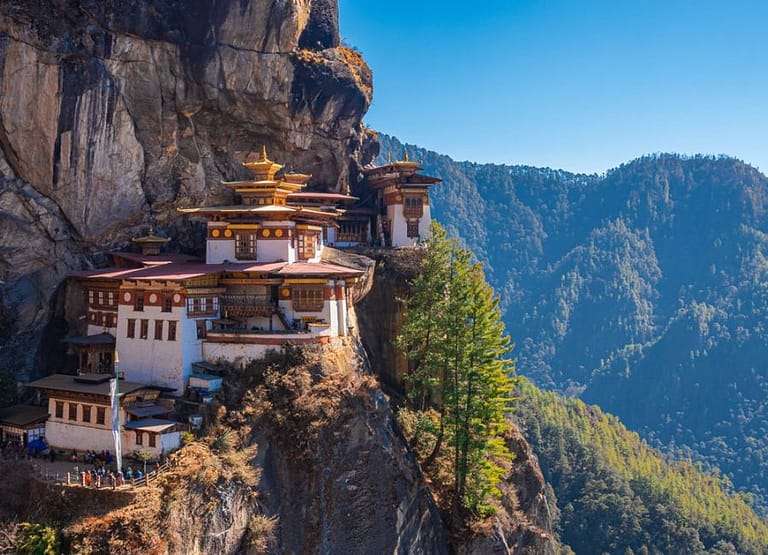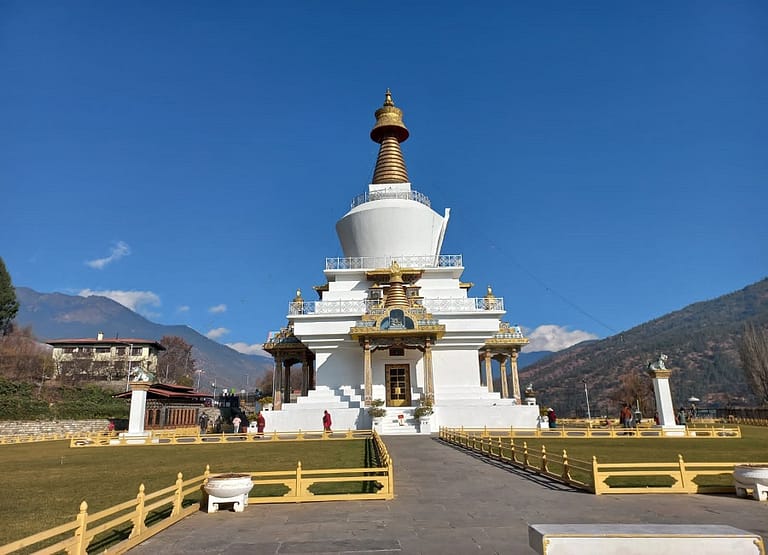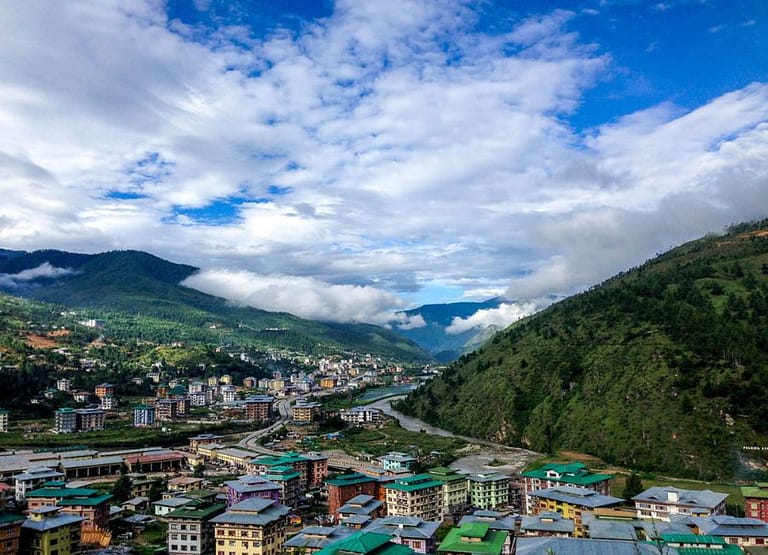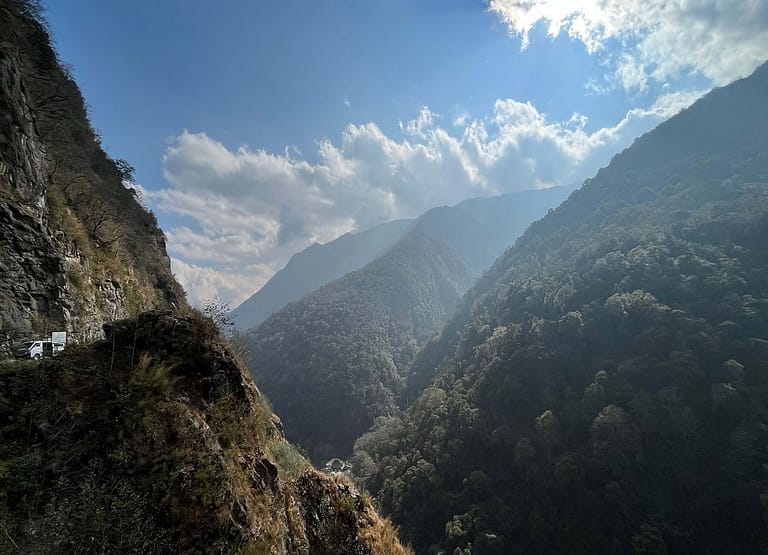Contact Us: +975- 17920418/17857895/77397369
PARO
Nestled in the heart of the Himalayas, Thimphu, the capital city of Bhutan, is a captivating blend of tradition and modernity. Despite being Bhutan’s largest city, Thimphu exudes a charming small-town atmosphere, where Bhutanese culture and values thrive. Amidst the backdrop of majestic mountains, visitors can explore a variety of attractions, from the magnificent Tashichho Dzong that serves as a symbol of Bhutanese architecture and administration, to the bustling markets where artisans sell intricate handicrafts and vibrant textiles. The city’s reverence for its heritage is evident in the Memorial Chorten and the Folk Heritage Museum, which provide insights into Bhutan’s spiritual and cultural legacy. Thimphu’s unique charm lies in its balance between tradition and progress, as seen in its emphasis on Gross National Happiness and its harmonious integration of traditional practices with modern advancements.
PLACES TO VISIT IN THIMPHU
Discover the mystical wonder that is Paro Taktsang, renowned across the lands as the “Tiger’s Nest.” This ethereal sanctuary, also known as Taktsang Palphug Monastery, stands as Bhutan’s crown jewel – an emblem of spiritual devotion and architectural marvel that leaves all who gaze upon it utterly captivated.
Perched courageously on the precipice of a cliff, some 900 meters above the lush embrace of Paro Valley, the Taktsang Lhakhang temple defies both gravity and convention. A sacred sentinel at an elevation of 3,120 meters, it beckons adventurers and pilgrims alike to partake in its otherworldly aura.
The story begins centuries ago, a tale interwoven with legend and reverence. In 1692, the first whispers of this sacred place took form as a temple within a cave, a hallowed spot where Guru Rimpoche, the great spiritual master, was said to have meditated in the 8th century A.D. The chronicles unfurl with an awe-inspiring tale: Guru Rimpoche soared upon a tigress, his divine consort, and alighted upon this very site. Here, ensconced within the cave’s embrace, he embarked on an extraordinary journey of meditation – a quest to conquer the malevolent demons lurking within.
For three years, three months, three days, and three hours, Guru Rimpoche delved into profound meditation, casting light upon the darkness that had held sway. The reverberations of his spiritual struggle have echoed through time, infusing the cave with an indomitable sanctity. A shrine of immense significance, it has drawn sages and saints from every corner, each seeking communion with the sublime.
Paro Taktsang, the sanctuary borne of legend and devotion, awaits your presence. Prepare to be ensnared by its gravity-defying splendor, where history converges with spirituality in a dance that transcends the earthly realm. Embark on a journey that will not only take you to the heights of a cliff but will also elevate your soul, leaving an indelible mark upon your heart – a testament to the enduring power of faith, courage, and the unbreakable bond between humans and the divine.
Behold the majestic fortress that is a testament to valor and victory – a creation of Zhabdrung Ngawang Namgyal in 1646, standing as a monumental homage to his triumph over marauding Tibetan forces. The very stones of this fortress resonate with the echoes of history, telling tales of courage and determination that have stood the test of time.
Although the flames of adversity consumed the fortress in 1951, its spirit endured, leaving behind remnants that command respect and admiration. The ruins, weathered by time, still stand in all their imposing grandeur, a reminder of the resilience that defines the human spirit.
This site, with its storied past, stands on the brink of a new chapter – a chapter of revival and rejuvenation. Envisioned as a UNESCO treasure, it has found its place on Bhutan’s Tentative List, a step closer to global recognition. The world awaits, poised to witness the fusion of history and heritage.
In 2016, a symphony of celebration resonated through these ancient walls. The birth of The Gyalsey, a moment of unparalleled joy, was intertwined with two other significant threads of history – the arrival of Zhabdrung Ngawang Namgyal in 1616 AD and the birth year of Guru Rinpoche. A triumphant announcement echoed, declaring the intent to rebuild and restore the fortress to its former glory. The foundation of this ambitious endeavor was laid just a day after the birth of the prince, a testament to the enduring spirit of heritage and hope.
Prepare to be captivated by this living narrative of Bhutan’s past and future. A pilgrimage to this resolute fortress is an essential part of your Paro journey, a rendezvous with the annals of time, and a witness to the indomitable force of history’s embrace.
Nestled within the embrace of sacred landscapes, Kyichu Lhakhang emerges as a radiant gem in the constellation of Himalayan Buddhist temples. It is not just a place; it is a resonance, an echo of devotion that reaches back through the tapestry of time.
Envision this temple as a radiant point within a cosmic mandala, an integral part of a celestial network woven around the Jo-khang temple at Lhasa. Within the heart of Lango Gewog in Paro District, its ethereal presence beckons seekers to traverse the inner pathways of spirituality.
The Jowo Temple of Kyichu, like an ancient hymn sung by kings and saints, carries with it an aura of venerable antiquity. In the 7th century, it emerged under the touch of Songtsen Gempo, the Tibetan King, a tribute to the divine dance of creation. It stands as a testament to his sacred endeavor, one of 108 border taming temples that span realms terrestrial and celestial.
Through the annals of time, a mystic breeze stirred within the temple’s hallowed halls. In the 8th century, the very footsteps of Padmasambhava graced its thresholds, bestowing upon it profound blessings. It is whispered that this sanctuary cradles hidden treasures of the spirit, enshrining them within its sacred walls.
The narrative takes an enchanting turn, as legends intermingle with devotion. The foundation of the first temple rests upon the left knee of an ogress – a symbolic gesture of subduing primal forces through spiritual grace. The temple itself, like a lotus in full bloom, stands as a testament to the power of transformation.
Time’s gentle fingers caressed the temple’s form in the 19th century, a restoration that breathed new life into ancient stones, preserving the sanctity that had been cherished for centuries. And in the tapestry of years, 1968 saw another chapter inscribed, as Ashi Kesang, the grand Queen Mother of Bhutan, added a harmonious resonance to the temple’s melody.
Kyichu Lhakhang transcends its earthly presence. It is a bridge between realms, an intersection where devotion, history, and spirituality converge. As you tread the hallowed path to this sanctuary, prepare to be enveloped in a symphony of centuries – a journey that traverses not only space but also the very essence of the soul.
Step into a realm where time itself is an artifact, where history and heritage converge to tell the tale of a kingdom’s evolution. Behold the National Museum of Bhutan, a treasure trove of cultural splendor nestled in the charming town of Paro. Established in 1968, under the visionary guidance of His Majesty, the third king, King Jigme Dorji Wangchuck, this museum breathes life into the threads of the past.
Venturing through its galleries is a voyage through epochs – a passage that chronicles the journey from the ancient echoes of the Stone Age to the vibrant mosaic of a modern Mahayanist Buddhist realm. Here, within these hallowed walls, Bhutan’s cultural essence is preserved like a fragrant bloom, its petals unfurling to reveal a harmonious fusion of tradition and contemporaneity.
More than just a collection of artifacts, the National Museum is a tapestry woven for connoisseurs, seekers of knowledge, scholars, and wanderers of all kinds. It beckons with a promise – a promise to immerse each visitor in a kaleidoscope of experiences, where colors, stories, and whispers from the past dance in harmonious rhythm.
This institution stands as a sentinel of Bhutan’s cultural legacy, echoing the nation’s commitment to preserving and promoting its profound values. In the symphony of Bhutan’s national development philosophy, Gross National Happiness, the preservation of culture is a vital chord, harmonizing with progress.
As you step into the museum’s embrace, you enter a sanctuary of artistry and history. Over 3,000 treasures – a precious reservoir of Bhutanese art spanning more than 1,500 years – await your gaze. A profound fusion of creative traditions and disciplines converges here, forming a bridge that spans eras and beckons the curious hearts of locals and travelers alike.
The National Museum of Bhutan isn’t just a destination; it’s an expedition into the heart of a kingdom’s soul. With each step, you become part of the intricate narrative that weaves past, present, and future into a tapestry of enchantment.
Nestled amidst the picturesque landscapes of Paro, Bhutan, lies a hidden gem that encapsulates the essence of Bhutanese spirituality and architectural brilliance – Dumtse Lhakhang. This enchanting temple, perched atop a hill, beckons explorers to step into a world where history, art, and devotion intertwine in perfect harmony.
Dumtse Lhakhang is more than a mere temple; it’s a living testament to Bhutan’s rich cultural heritage. Built in the 15th century by Thangtong Gyalpo, a renowned saint, architect, and bridge-builder, the temple exudes an air of timeless wisdom. Its three-storey structure, designed like a chorten, or a stupa, is a symbol of spiritual ascent, inviting pilgrims and visitors to ascend not just the physical steps but also the metaphorical journey of the soul.
Inside its walls, intricate murals and vivid paintings unfurl stories of legends and deities, offering a glimpse into Bhutan’s spiritual tapestry. The frescoes beautifully depict the cosmic battles between good and evil, and the celestial beings that watch over the world. Each brushstroke carries the weight of centuries, preserving the spiritual essence of a nation that treasures its traditions.
Dumtse Lhakhang’s allure isn’t just in its architectural magnificence or artistic finesse; it’s also in the devotion it has inspired for generations. Pilgrims circumambulate its corridors, prayer wheels in hand, sending their aspirations into the universe. The tranquil atmosphere provides a space for reflection and meditation, inviting individuals to seek solace and connection amidst the bustling world.
As you ascend the hill to Dumtse Lhakhang, you’re not just visiting a historical site – you’re embarking on a sacred journey. The whispers of the past and the echoes of devotion infuse every stone, every mural, and every prayer flag that dances in the wind. It’s a place where time stands still, and the spirit finds its sanctuary.
Whether you’re a traveler with a penchant for cultural exploration or a seeker of spiritual enlightenment, Dumtse Lhakhang offers an experience that transcends the ordinary. It’s an opportunity to immerse yourself in Bhutan’s soul-stirring traditions, to walk the path of saints and pilgrims, and to leave with a piece of its mystique etched into your heart forever.






